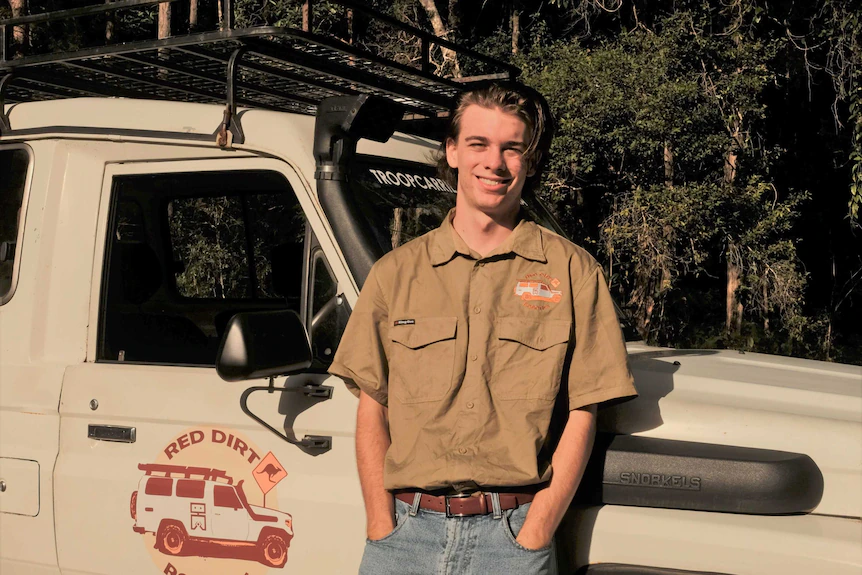
Bridget Judd from ABC recently caught up with past Mayor’s Telstra Innovation Awards participant Jameson Harvey. The following article was published on www.abc.com.au.
Trial and error: it’s a simple but frustrating strategy.
If you ask Jameson Harvey, however, it’s all part of the process.
“There’s always lots of lots of problem-solving that you have to do when you’re working on robots,” he laughs.
“And, as soon as you think you’ve figured something out, and you’ve finally got it working, I guarantee something else will happen.”
After tagging along with a couple of mates to his school’s robotics club in 2017, Jameson felt “the rush”.
His love for all things STEM quickly catapulted him from the suburbs of the Sunshine Coast onto the world stage.
“In 2019, my team and I took out second place at the FIRST Lego League World Festival, which is the world’s biggest robotics competition in Houston, Texas,” the 18-year-old says.
“When we came back from America, we thought that we should start to pass that knowledge on.”
It ignited a passion to make robotics accessible to everyone, irrespective of where they lived.
And, from his humble “old Troopy”, Jameson is now mixing dirt and determination to shape the next generation of young engineers.
‘Robotics is just growing and growing’
Employment in STEM occupations is projected to grow by 12.9 per cent in the next five years, well above the average of all occupations (7.8 per cent).
However, students in remote, rural and regional Australia are being left behind.
The average 15-year-old from remote Australia is around 1.5 years behind metropolitan students in science, while students from regional and remote areas are under-represented in the STEM workforce.
“STEM and robotics, robotics especially, it’s going to have some sort of footing in just about every industry that there is: agriculture, mining, and manufacturing, which it’s already pretty centred in,” Jameson says.
“Robotics is just growing and growing and growing.”
Sectors such as engineering will be more important than ever in the future, echoes Chris Stoltz, a professor in engineering practice at La Trobe University.
However, the industry is currently hamstrung by a lack of engineers.
“The demand pre-COVID was about 16,000 engineers here, and universities are only producing about 9,000,” says Professor Stoltz, who teaches on La Trobe’s Bendigo campus, in central Victoria.
“The shortage of engineers is such that some of the companies in regional areas have had to resort to sponsoring [employees from overseas].”
‘You can develop the next big thing’
For those within the sector, the state of play is simple: Australia’s capacity to produce its own engineers begins at school.
However, while participation in STEM subjects is languishing across the board, particularly among girls, research has found students from regional and remote areas are more likely to have negative perceptions of STEM disciplines and are less likely to pursue a career in those areas.
This divide between regional and metropolitan outcomes is influenced by a myriad factors, not limited to a lack of resources, difficulties in finding and retaining qualified STEM teachers, and fewer career and further education opportunities.
But moves are afoot to bridge the gap.
Dubbed Red Dirt Robotics, Jameson is heading off on a 12-month road trip, visiting regional schools in outback Queensland, the Northern Territory and Western Australia to teach students essential skills for STEM-based subjects and future jobs.
“What I found is that close to none of these students have ever seen or touched or even really heard of robotics and what it can do, and what it means to them at a primary school or high school level,” Jameson says.
“A lot of the teachers who I’m getting in contact with, they want to have these robotics programs in their schools and their courses.
“But they don’t have the knowledge themselves to be teaching a class of students or they don’t have the funding through that school to be able to justify buying a whole robotics kit.”
From the “deserts of Western Australia to everywhere in between”, Jameson teaches students the foundation skills of programming and coding a robot, and what it takes to build something that is not only going to work, but “be strong and functional”.
He wants to give children a sense of what it is like to compete in robotics competitions, “so that, hopefully, they can get that same sort of rush that I did, and then develop their own passion”.
“For a lot of the places that I’m visiting, they’ll be mining towns, or they’ll be agricultural towns,” Jameson says.
“I want to show the kids in these classrooms that there’s more to just working on the farm or going into the mines for your 12-hour shift.
“You can develop the next big thing to be able to combat some of the issues that you’ve seen working on a farm or working in the mines.”